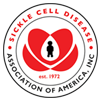Trusted Resources: Evidence & Education
Scientific literature and patient education texts
Risk factors for Venous Thrombo-Embolism (VTE) in children with Sickle Cell Disease (SCD): a multicenter cohort study
source: American Society of Pediatric Hematology/Oncology
year: 2017
authors: Riten Kumar, Joseph Stanek, Susan Creary, Sarah H. O'Brien
summary/abstract:Background:
A hypercoagulable state resulting in increased VTE has been described in adults with SCD. Similar data for children is lacking. Previously, in a single-institution, retrospective study of 414 pediatric patients with SCD followed at Nationwide Children’s Hospital, we identified central venous catheters (CVC) as an independent risk factor for VTE [OR (± 95%CI): 10.3 (1.1-92.2)]. 12/414 (2.9%) subjects developed VTE over the course of the study.
Objectives:
The objective of this retrospective, multicenter cohort study was to describe risk factors associated with VTE in children with SCD across children’s hospitals in the United States (US).
Results:
A total of 8966 unique subjects (4359 female) met inclusion criteria with a mean age (±SD) of 10.3 (±6.4) years. 160 subjects (96 female) developed VTE during the study period. Mean age (±95%CI) at VTE diagnosis was 14.8 (±5.9) years. On multivariate analysis, CRD [OR (±95%CI): 5.2 (2.5-11.1)], any CVC placement [4.2 (3.1-5.9)]; history of stroke [2.5 (1.5-4.1)]; female gender [1.6 (1.1-2.2); and older age at admission [1.1 (1.06-1.12)] were identified as risk factors associated with VTE diagnosis. There was a positive correlation between the number of CVCs placed/1000 patients and the number of VTE diagnosed/1000 patients (p=0.02).
Conclusion:
Rate of VTE in children with SCD admitted to children’s hospital in the US is around 1.8%. CVC use is associated with a nearly 4-fold increased risk of VTE diagnosis. Additionally, CRD, history of stroke, female gender and older age at admission were also associated with VTE diagnosis. Prospective cohort studies are needed to confirm these findings and develop risk prediction models for VTE in children with SCD.
Related Content
-
Camp New Hope 2022Camp New Hope is a seven-day; six-night ...
-
Promising results at 1 year follow-up following familial haploidentical (FHI) T-cell depleted (TCD) with CD34 enrich...AlloSCT from HLA-matched MSD has been su...
-
Lisa Pullens, RN, BSN, CPHNLisa received her RN-BSN 33 years ago at...
-
Sickle Cell Disease Coalition (SCDC)https://www.youtube.com/watch?v=oQP-Uq0B...
-
Study Confirms Safe Use of Opioids for Pain Control in Sickle Cell DiseaseThe most common cause of hospital admiss...
-
The clinical presentation, utilization, and outcome of individuals with sickle cell anaemia presenting to urban emer...Background: Sickle cell anaemia (SCA) i...
-
Emmaus Life Sciences Receives Validation From European Medicines Agency on Marketing Authorization Application for S...Emmaus Life Sciences, Inc. announced tod...
To improve your experience on this site, we use cookies. This includes cookies essential for the basic functioning of our website, cookies for analytics purposes, and cookies enabling us to personalize site content. By clicking on 'Accept' or any content on this site, you agree that cookies can be placed. You may adjust your browser's cookie settings to suit your preferences. More Information
The cookie settings on this website are set to "allow cookies" to give you the best browsing experience possible. If you continue to use this website without changing your cookie settings or you click "Accept" below then you are consenting to this.




 +myBinder
+myBinder
